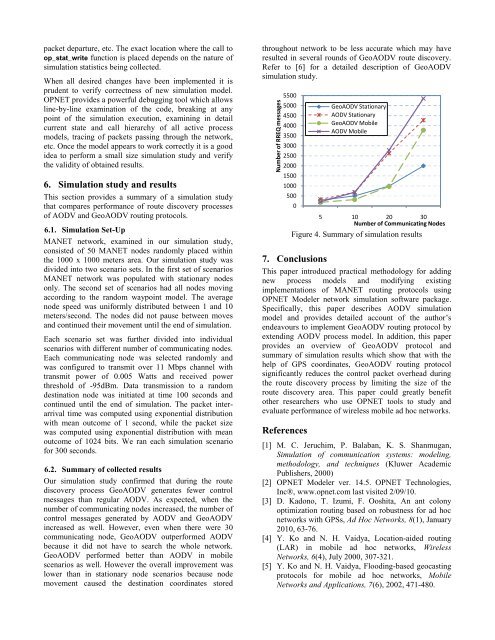practical methodology for modeling wireless routing protocols
practical methodology for modeling wireless routing protocols
practical methodology for modeling wireless routing protocols
Create successful ePaper yourself
Turn your PDF publications into a flip-book with our unique Google optimized e-Paper software.
packet departure, etc. The exact location where the call to<br />
op_stat_write function is placed depends on the nature of<br />
simulation statistics being collected.<br />
When all desired changes have been implemented it is<br />
prudent to verify correctness of new simulation model.<br />
OPNET provides a powerful debugging tool which allows<br />
line-by-line examination of the code, breaking at any<br />
point of the simulation execution, examining in detail<br />
current state and call hierarchy of all active process<br />
models, tracing of packets passing through the network,<br />
etc. Once the model appears to work correctly it is a good<br />
idea to per<strong>for</strong>m a small size simulation study and verify<br />
the validity of obtained results.<br />
6. Simulation study and results<br />
This section provides a summary of a simulation study<br />
that compares per<strong>for</strong>mance of route discovery processes<br />
of AODV and GeoAODV <strong>routing</strong> <strong>protocols</strong>.<br />
6.1. Simulation Set-Up<br />
MANET network, examined in our simulation study,<br />
consisted of 50 MANET nodes randomly placed within<br />
the 1000 x 1000 meters area. Our simulation study was<br />
divided into two scenario sets. In the first set of scenarios<br />
MANET network was populated with stationary nodes<br />
only. The second set of scenarios had all nodes moving<br />
according to the random waypoint model. The average<br />
node speed was uni<strong>for</strong>mly distributed between 1 and 10<br />
meters/second. The nodes did not pause between moves<br />
and continued their movement until the end of simulation.<br />
Each scenario set was further divided into individual<br />
scenarios with different number of communicating nodes.<br />
Each communicating node was selected randomly and<br />
was configured to transmit over 11 Mbps channel with<br />
transmit power of 0.005 Watts and received power<br />
threshold of -95dBm. Data transmission to a random<br />
destination node was initiated at time 100 seconds and<br />
continued until the end of simulation. The packet interarrival<br />
time was computed using exponential distribution<br />
with mean outcome of 1 second, while the packet size<br />
was computed using exponential distribution with mean<br />
outcome of 1024 bits. We ran each simulation scenario<br />
<strong>for</strong> 300 seconds.<br />
6.2. Summary of collected results<br />
Our simulation study confirmed that during the route<br />
discovery process GeoAODV generates fewer control<br />
messages than regular AODV. As expected, when the<br />
number of communicating nodes increased, the number of<br />
control messages generated by AODV and GeoAODV<br />
increased as well. However, even when there were 30<br />
communicating node, GeoAODV outper<strong>for</strong>med AODV<br />
because it did not have to search the whole network.<br />
GeoAODV per<strong>for</strong>med better than AODV in mobile<br />
scenarios as well. However the overall improvement was<br />
lower than in stationary node scenarios because node<br />
movement caused the destination coordinates stored<br />
throughout network to be less accurate which may have<br />
resulted in several rounds of GeoAODV route discovery.<br />
Refer to [6] <strong>for</strong> a detailed description of GeoAODV<br />
simulation study.<br />
Number of RREQ messages<br />
5500<br />
5000<br />
4500<br />
4000<br />
3500<br />
3000<br />
2500<br />
2000<br />
1500<br />
1000<br />
500<br />
0<br />
5 10 20 30<br />
Number of Communicating Nodes<br />
Figure 4. Summary of simulation results<br />
7. Conclusions<br />
This paper introduced <strong>practical</strong> <strong>methodology</strong> <strong>for</strong> adding<br />
new process models and modifying existing<br />
implementations of MANET <strong>routing</strong> <strong>protocols</strong> using<br />
OPNET Modeler network simulation software package.<br />
Specifically, this paper describes AODV simulation<br />
model and provides detailed account of the author’s<br />
endeavours to implement GeoAODV <strong>routing</strong> protocol by<br />
extending AODV process model. In addition, this paper<br />
provides an overview of GeoAODV protocol and<br />
summary of simulation results which show that with the<br />
help of GPS coordinates, GeoAODV <strong>routing</strong> protocol<br />
significantly reduces the control packet overhead during<br />
the route discovery process by limiting the size of the<br />
route discovery area. This paper could greatly benefit<br />
other researchers who use OPNET tools to study and<br />
evaluate per<strong>for</strong>mance of <strong>wireless</strong> mobile ad hoc networks.<br />
References<br />
GeoAODV Stationary<br />
AODV Stationary<br />
GeoAODV Mobile<br />
AODV Mobile<br />
[1] M. C. Jeruchim, P. Balaban, K. S. Shanmugan,<br />
Simulation of communication systems: <strong>modeling</strong>,<br />
<strong>methodology</strong>, and techniques (Kluwer Academic<br />
Publishers, 2000)<br />
[2] OPNET Modeler ver. 14.5. OPNET Technologies,<br />
Inc®, www.opnet.com last visited 2/09/10.<br />
[3] D. Kadono, T. Izumi, F. Ooshita, An ant colony<br />
optimization <strong>routing</strong> based on robustness <strong>for</strong> ad hoc<br />
networks with GPSs, Ad Hoc Networks, 8(1), January<br />
2010, 63-76.<br />
[4] Y. Ko and N. H. Vaidya, Location-aided <strong>routing</strong><br />
(LAR) in mobile ad hoc networks, Wireless<br />
Networks, 6(4), July 2000, 307-321.<br />
[5] Y. Ko and N. H. Vaidya, Flooding-based geocasting<br />
<strong>protocols</strong> <strong>for</strong> mobile ad hoc networks, Mobile<br />
Networks and Applications, 7(6), 2002, 471-480.
















